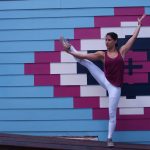Our scapula, or shoulder blade, glides around on the chest wall allowing the complex movements that we use in our asana. It plays a vital role in keeping the scapula firmly fixed on the chest wall. Here is how to activate, strengthen and make the most of this important muscle in your classes.
The When and Where of Serratus Anterior
The primary muscle of the shoulder, serratus anterior, originates from muscular slips on the outer surfaces of the first eight or nine ribs at the front of the rib cage. You can see these origins in people with a very muscular chest and abs. The muscle passes up and back around the side of the chest wall — passing between the scapula and subscpularis muscle before inserting into the medial border of the scapula. It connects the scapula to the ribcage and contributes a massive amount to the stability of the whole arm. It really is a huge part of the foundation of the upper limb.
Also known as the ‘boxers muscle’ because it really comes into it’s own when punching; serratus anterior holds the scapula firmly on the chest wall at the same time as protracting the scapula. This causes upward rotation of the scapula and lifts the shoulder joint to point more skywards. This opens up the possibility of a whole range of overhead arm positions that we use in yoga.
Weak Shoulders?
Weakness in serratus anterior allows the medial border of the scapula to drift away from the chest wall. This is called a winging scapula. Here the scapula lifts a way from the chest giving the impression that there is a little wing trying to unfurl. You can see this a lot in yoga students trying to hold a plank or do chaturanga before they have the strength to do so. The idea of a little wing may be cute but the reality of this situation is far more sinister. If students persist in working with a winged scapula they risk developing a range of shoulder problems. A winged scapula is a clear indication that the student needs a modified version of that pose.
Serratus anterior’s protracting action is balanced by the rhomboid muscles drawing the scapulae together. It is also enhanced by the pectorals on the front of the chest wall. Contracting the rhomboids too much stops the scapula from protracting. But no retraction at all will let the scapula fly off round the chest wall willy nilly. Neither is good — as always in yoga, we are after balance.
See Also: 5 Simple Poses to Strong Shoulders
Strengthening in Practice
Before we can think about strengthening the muscle and activating it in practice we need to be able to feel it working. Every yoga teacher has their favourite exercises, but I like these simple ones best. Students seem to get the hang of then easily and they work in an open class where more subtle work is difficult:
- Weight bearing protraction — Start on hands and knees as if you were going into cat and cow. Keeping the arms still, push through the hands and draw the shoulder blades forwards round the chest wall. The torso rises up between the scapulae but the spine itself should not move. Then lower the torso in controlled manner. A few repetitions of this isolates serratus anterior nicely. It is also a great exercise for teaching the connection between protracting the shoulders and grounding through the hands in preparation for stronger weight bearing work.
- Angry cat and cow — Once students have the hang of protracting in isolation you can add it into the cat phase of cat and cow. This is also a lovely rhomboid stretch at the same time. Cue the movement of the scapulae as you go through the cycle; in cat they glide forwards, in cow they come back together.
- Modified plank — Working in a plank with knees down, encourage widening of the space between the shoulder blades at the same time as gently activating the rhomboids. Cueing a little squeeze between the shoulder blades as they glide away from the spine helps give students the right idea. This can be progressed to full plank and chaturanga as
strength and co-ordination improve. Remember, if the scapula is winging it is one progression too far.
- Plank to down dog pulses — For the more advanced student, moving slowly between plank and down dog for a few repetitions will continue to develop strength in serratus anterior.
The Long and Short of Serratus Anterior
Any poses that strongly activate the rhomboids will automatically stretch and relax serratus anterior through a combination of simple mechanics and reciprocal inhibition. So you could use purvottanasana, or the more accessible table top version, and cue strong rhomboid action. Strongly drawing the shoulder blades together in bridge will also help to lengthen serratus anterior.
Getting to grips with serratus anterior is a game changer in a students yoga journey. Suddenly poses like down dog and headstand become so much easier and far more controlled. Niggling shoulder and wrist problems often disappear as serratus anterior gets in on the act and asana becomes less of a struggle and more fulfilling.
So, if you are wondering about the theme for your next class, serratus anterior could be just the thing. It really is a foundation of good practice.













